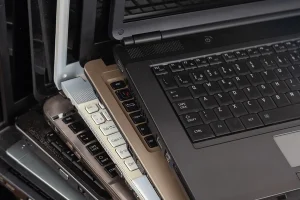
Hello Reader!
Welcome to the blog page of Ctech IT Solutions, one of the best laptop repair service center in Kolkata.
Mac devices are known for their premium build quality, smooth performance, and cutting-edge technology. However, even the most advanced machines are not entirely free from technical glitches. One common problem faced by many users is the Screen Flickering issue in Mac. This problem can be extremely frustrating as it disrupts productivity, strains the eyes, and makes using the device uncomfortable.
At Ctech IT Solutions, the Best Laptop Repair Service Center in Kolkata, we have encountered and successfully resolved countless cases of screen flickering in Mac devices. In this blog, we will discuss what this issue is, the possible reasons behind it, and effective ways to resolve it.

What is Screen Flickering Issue in Mac?
The Screen Flickering issue in Mac refers to a visual disturbance where the display intermittently flashes, blinks, or shows horizontal/vertical lines. It may occur randomly or during specific activities such as scrolling, opening apps, or after waking the device from sleep mode.
While it might seem like a minor inconvenience at first, if left unchecked, this issue could lead to permanent screen damage or affect the usability of your Mac.
Causes of Screen Flickering Issue in Mac
Several factors can contribute to the Screen Flickering issue in Mac, including:
- Software Bugs or Compatibility Issues
- Outdated macOS versions or incompatible applications may trigger screen flickering.
- Outdated macOS versions or incompatible applications may trigger screen flickering.
- Display Settings Misconfiguration
- Improper resolution or refresh rate settings can cause flickering problems.
- Improper resolution or refresh rate settings can cause flickering problems.
- Graphics Processing Unit (GPU) Problems
- Macs with dedicated or integrated graphics sometimes face driver or GPU-related issues.
- Macs with dedicated or integrated graphics sometimes face driver or GPU-related issues.
- Loose or Faulty Display Connections
- Internal hardware connection problems between the display and motherboard.
- Internal hardware connection problems between the display and motherboard.
- Hardware Damage
- Physical damage, accidental drops, or liquid exposure can also trigger flickering.
- Physical damage, accidental drops, or liquid exposure can also trigger flickering.
- Third-Party Apps
- Certain third-party apps that modify system visuals or display performance may lead to flickering.
- Certain third-party apps that modify system visuals or display performance may lead to flickering.

How to Resolve Screen Flickering Issue in Mac?
If you are experiencing the Screen Flickering issue in Mac, here are some practical solutions:
1. Update macOS
Keeping your operating system updated ensures you have the latest bug fixes and performance improvements. Go to System Preferences > Software Update and install available updates.
2. Reset NVRAM and SMC
Sometimes resetting NVRAM (Non-Volatile Random-Access Memory) and SMC (System Management Controller) can fix screen flickering. These resets clear out temporary settings that might be causing display issues.
3. Check Display Settings
Navigate to System Settings > Displays and ensure the resolution and refresh rate are set correctly. Choosing the “Default for Display” option can often resolve flickering.
4. Boot in Safe Mode
Restart your Mac in Safe Mode to check whether third-party apps are causing the issue. If flickering doesn’t occur in Safe Mode, an application might be responsible.
5. Disable Automatic Graphics Switching
For MacBooks with dual graphics, disabling Automatic Graphics Switching in System Preferences > Energy Saver sometimes resolves flickering problems.
6. Hardware Inspection
If the problem persists, it might be due to internal hardware damage or loose display connectors. In such cases, visiting the Best Laptop Repair Service Center in Kolkata, like Ctech IT Solutions, is the most reliable option.

What are common causes of Screen Flickering issue in Mac?
Common causes of Screen Flickering issue in Mac include hardware faults, software glitches, incompatible settings, and environmental factors such as overheating or liquid exposure.
Main Reasons for Mac Screen Flickering
- Display Hardware Issues: Loose, damaged, or faulty display cables, connectors, or defective screens can trigger flickering or lines on a MacBook display.
- Software Glitches and Bugs: Outdated or buggy macOS system files—especially after major updates—can cause display instability and flickering, as can corrupted PRAM or SMC settings.
- Graphics Card Problems: Both older and newer Macs can experience flickering due to failing or incompatible graphics cards, outdated drivers, or automatic GPU switching between integrated and discrete cards.
- Overheating: Excessive heat from blocked vents, dust buildup, or intensive apps can cause thermal throttling, affecting GPU and display performance and leading to flickers.
- Display Resolution or Refresh Rate Conflicts: Unsupported display resolution settings, external monitor issues, or mismatched refresh rates can cause flickering problems.
- Physical and Liquid Damage: Drops, impacts, or exposure to moisture may damage the display circuitry or logic board, resulting in persistent screen glitches.
- Background Apps or Malware: Third-party software conflicts (especially graphics-heavy apps) and malware can interfere with normal operation, consuming resources and causing display anomalies.
- Duplicate Color Profiles: Having duplicate or corrupted color profiles can be another trigger for screen flickering.
Also Read: Fixing MacBook Running Slow Issue: Easy Steps To Speed Up Mac at Home

How can you troubleshoot software-related screen flickering on Mac?
To troubleshoot software-related screen flickering on Mac, follow these proven steps to isolate and resolve the issue before seeking hardware intervention:
Essential Steps for Software Troubleshooting
- Restart Your MacBook: A simple reboot often clears temporary caches and refreshes system processes, which can resolve minor flickering.
- Update macOS: Install the latest version by going to System Settings > General > Software Update. Updates frequently include important bug fixes for display issues.
- Reset PRAM/NVRAM: For Intel Macs, shut down the device, then turn it on while holding Option + Command + P + R for 20 seconds. This resets display and startup disk settings.
- Reset SMC: For Intel-based Macs, shut down, then hold Control + Option (left) + Shift (right) for 7 seconds; add the power button for another 7 seconds, release all keys, wait a few seconds, then reboot.
- Change Display Settings: Go to System Settings > Displays, set resolution to Default, uncheck custom scaling, and set the refresh rate to 60Hz if available.
- Delete Duplicate Color Profiles: Remove duplicate or corrupted color profiles from System Settings > Displays > Color Profile to prevent glitches.
- Disable Automatic Graphics Switching: For Macs with dual GPUs, go to System Settings > Battery > Options and disable automatic graphics switching.
- Boot into Safe Mode: Restart with the Shift key held down. In Safe Mode, only core system processes run. If flickering stops, uninstall or update problematic third-party apps.
- Check for Malware: Use a malware scanner or dedicated app like CleanMyMac to detect and remove background threats that may cause flickering.

What hardware components are most likely causing flickering on Mac?
The hardware components most likely responsible for causing screen flickering on Mac include the display cable (especially the flex cable), the display panel itself, the graphics card (GPU), and the logic board.
Key Hardware Culprits
- Display/Flex Cable: Loose, damaged, or worn-out internal cables (such as the flex cable) connecting the screen to the logic board can cause intermittent flickering. The “flexgate” issue in certain MacBook Pro models is a common example.
- Display Module/Panel: A defective or physically damaged screen (including a faulty backlight) displays lines, flickers, or random blackouts.
- Graphics Card (GPU): Failing or overheating graphics chips, or problems with GPU switching (dual GPU models), can cause intensive flickering and graphics anomalies.
- Logic Board: Damage from drops, moisture, or aging can disrupt the communication between display subsystems, leading to persistent flickers.
- Power Supply or Battery: Unstable voltage delivery from a faulty charger, battery, or internal power circuitry may also trigger flickering symptoms.
- External Monitor Connectors: Issues with HDMI, Thunderbolt, or display adapters connecting external screens can cause display instability or flicker on connected monitors.

How can you prevent future screen flickering issues in MacBook?
To prevent future screen flickering issues in your MacBook, it’s important to adopt a combination of safe usage habits, regular maintenance, and system updates. Here are key strategies to keep your MacBook screen stable and flicker-free:
- Handle Carefully: Avoid pressing on or applying uneven pressure to the MacBook screen, especially when opening or closing the lid, as this can damage internal flex cables that cause flickering over time.
- Keep Software Updated: Regularly update macOS to the latest stable version to benefit from bug fixes and improved graphic drivers that reduce flicker-related glitches.
- Avoid Beta Software: Use only official macOS releases instead of beta versions, which may have untested bugs causing screen issues.
- Regularly Reset System Settings: Periodically reset PRAM/NVRAM and SMC to refresh hardware and display-related configurations and prevent software conflicts.
- Disable Automatic Graphics Switching: On models with dual GPUs, disabling auto GPU switching prevents flickers caused by switching between graphic cards.
- Manage Display Settings: Avoid using Dark Mode or True Tone if flickering occurs, and keep display resolution and refresh rates at recommended defaults.
- Prevent Overheating: Use your MacBook on hard, flat surfaces for proper ventilation. Clean dust from vents and consider cooling pads during heavy usage.
- Avoid Liquid Exposure and Damage: Prevent exposure to moisture and physical shocks that can damage display circuitry or connectors.
- Keep Malware-Free: Use antivirus software to keep malware and problematic third-party apps that could affect display performance at bay.
- Seek Professional Maintenance: Schedule regular checkups with reliable service providers like Ctech IT Solutions, the Best Laptop Repair Service Center in Kolkata, to detect and fix minor hardware issues before they escalate.

What software settings can reduce MacBook screen flickering risks?
To reduce the risk of MacBook screen flickering through software settings, here are the key adjustments and actions that can help stabilize your display:
- Update macOS Regularly: Keep your MacBook running the latest macOS version via System Settings > General > Software Update. Updates often fix bugs and improve graphics driver compatibility.
- Turn Off True Tone and Dark Mode: Both True Tone and Dark Mode can sometimes cause flickering. Disable them in System Settings > Displays (for True Tone) and System Settings > General > Appearance (switch to Light mode).
- Disable Automatic Graphics Switching: For MacBooks with dual GPUs, turn off automatic graphics switching in System Settings > Battery > Options. This prevents flicker caused by the system switching between integrated and discrete graphics.
- Reset PRAM/NVRAM and SMC: These resets refresh display and hardware management configurations, which can clear flicker-inducing glitches.
- Adjust Display Resolution and Refresh Rate: Use default display resolutions and set the refresh rate to 60Hz where applicable under System Settings > Displays.
- Disable Hardware Acceleration in Apps: Sometimes app-specific hardware acceleration causes flicker. Disable this feature in browsers or graphic-heavy apps.
- Boot into Safe Mode: Restarting in Safe Mode disables third-party extensions and caches, helping identify if software conflicts cause flickering.
- Clear Cache and Run Maintenance Tasks: Use built-in or third-party tools to clear system caches and run maintenance scripts that optimize performance.
These software settings and routine maintenance steps help reduce flickering risks by addressing driver issues, preventing rapid GPU switching, and eliminating problematic system states.
Which macOS updates most effectively prevent screen issues?
The macOS updates that most effectively prevent screen issues, including screen flickering on Mac, are the recent versions within the macOS Sequoia series (macOS 15.x). These updates provide important bug fixes, performance improvements, and security patches that enhance display stability and graphics driver compatibility.
Notable macOS Updates for Preventing Screen Issues:
- macOS Sequoia 15.6.1 and 15.6: These are the latest updates recommended for all users, providing critical bug fixes and security updates. They also address display compatibility issues, including fixes for external monitors and improvements to GPU memory allocation on advanced Mac Studio models.
- macOS Sequoia 15.5 and 15.4: These included various bug fixes that improve system stability and address issues such as external display flickering and Night Shift turning off incorrectly, which can indirectly affect screen flicker behavior.
- Regular Security Updates: Apple continuously addresses security vulnerabilities that can affect system stability. Installing the newest updates reduces the risk of software-related screen errors caused by exploitable bugs in older versions.
- Performance Enhancements for Graphics-Intensive Apps: Some updates optimize graphics performance for professional apps (e.g., Final Cut Pro), which can minimize flickering under heavy GPU loads on high-end Macs.
Why Keeping macOS Updated Matters for Screen Stability:
- Updates often include refined graphics drivers and system-level bug fixes that resolve previously reported flickering and display issues.
- Compatibility improvements ensure better interaction between macOS and hardware components such as GPUs and display panels.
- Security patches also help prevent malicious software or system misconfigurations from causing erratic screen behavior.
For smooth and flicker-free Mac operation, regularly check for software updates in System Settings > Software Update and apply recommended macOS versions, particularly within the current Sequoia series, as emphasized by expert sources.
Why Choose Ctech IT Solutions for Screen Flickering Issues?
At Ctech IT Solutions, we pride ourselves on being the Best Laptop Repair Service Center in Kolkata. Our team of certified technicians specializes in handling Mac-related issues, including the Screen Flickering issue in Mac.
- ✅ Expert diagnosis of hardware and software issues
- ✅ Genuine spare parts and high-quality repairs
- ✅ Affordable pricing with transparency
- ✅ Quick turnaround time
- ✅ Trusted by thousands of customers in Kolkata
Whether the issue is software-related or caused by hardware damage, we provide the right solution to restore your Mac’s smooth performance.
Final Words
The Screen Flickering issue in Mac can occur due to various reasons, from minor software glitches to serious hardware faults. While you can try basic troubleshooting methods at home, persistent issues require professional attention.
If you are facing this problem, don’t wait until it gets worse. Visit Ctech IT Solutions, the Best Laptop Repair Service Center in Kolkata, and let our experts bring your Mac back to perfect working condition.








